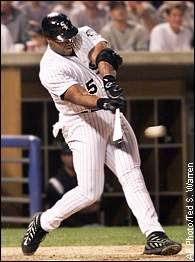Trade number 17: Randy Velarde to Texas for Aaron Harang and Ryan Cullen
In his first trade of the 2001 off-season, Beane trade Randy Velarde and his $3 million salary in exchange for two youngsters. Cullen never spent significant time in the Major leagues, but Harang did, pitching in parts of two seasons for the Athletics before being trade to Cincinatti. During these two season segments, Harang pitched just above replacement level before being utilized in the deal that brought Jose Guillen to Oakland. Velarde did not last a season in Texas as he was traded mid-season to the Yankees. In his 296 at bats as a Ranger, he established a VORP of 16.5 and had an OPS+ of 117. His Oakland replacement did not fare as well; Frank Menechino had an OPS+ of 101 during the 2001 season.
Trade number 18: Matt Stairs to the Cubs for Eric Ireland
After a subpar 2000 season, designated hitter Matt Stairs was deemed quite expendable by the Athletics and traded to the Cubs for minor leaguer Eric Ireland. Ireland never did anything significant at the major league level. Stairs meanwhile raised his OPS+ to 114 in 2001, up from 93 in 2000, and established a VORP of 10.5 while earning a salary of over $3 million. All in all, this was an effective salary dump by Beane and co.
Trade number 19: Miguel Olivo for Chad Bradford
Looking for undervalued players as always, Beane and co. targeted Bradford from the Chicago White Sox. The love for Bradford is described in Moneyball if you haven’t yet read it, it’s the chapter entitled Anatomy of an Undervalued Pitcher. To acquire the minimum salaried reliever, the Athletics gave up prospect catcher Miguel Olivo. Olivo would spend a couple unspectacular (VORPs of -5.1, 7.8 and OPS+ of 70 and 102) seasons with the White Sox before being shipped to the Mariners in the Freddy Garcia deal. Bradford would spend 4 seasons in the Oakland bullpen, always pitching above replacement level (VORPs of 11.3, 18.1, 24.2 and 9.2) and with ERA+ of 161, 150, 140 and 106. He was then traded to the Red Sox in July 2005 in exchange for Jay Payton. All in all, this was an effective use of the prospect Olivo, for a reliable reliever who was then traded for an outfielder still with the team.
Trade number 20: Ben Grieve, AJ Hinch, Angel Berroa for Cory Lidle, Johnny Damon and Mark Ellis
Oakland management completed another three way trade, this time to acquire a leadoff hitter, starting pitcher and a young second baseman. Grieve and Berroa were seen as top young players, however Grieve regressed after the trade with VORPs of 13.5, 11.2 and 2.3 that could be explained by shrinking home run numbers (from 27 in 2000 to 11, 19 and 4 the next three seasons). He went from being one of the next great power hitters to a below average hitter with an over-inflated contract. Berroa seemed to live up to expectations in his first full season as a Major Leaguer in 2003, winning the Rookie of the Year and establishing a VORP of 34. However, his OPS+ was below average at 96 and unfortunately, Berroa has not been able to match his performance of his first season. Hinch was a negative producer in parts of two season; with a combined VORP of -1.7.
As for the players received, Damon was actually not as good as advertised during his only season as an Athletic, establishing a VORP of only 4.7 while having an OPS+ of 85 and being caught stealing 12 times on 39 attempts. He was let go as a free agent at the end of the season and the Athletics would receive two picks (17 and 39) for their loss, one of these picks would be utilized to select Nick Swisher. Mark Ellis would become a regular major leaguer in 2002 and play above replacement level for the 2002, 2003, 2005 and 2006 seasons with a career high OPS+ of 125 in 2005. Finally, Cory Lidle would give the Athletics two consecutive seasons of over 180 innings pitched above replacement level with VORPs of 34 and 29. He had a combined record of 21 and 16 in his two seasons with Oakland and ERA+ of 121 and 119. All in all this was a good deal by the Athletics as they dealt a commodity that was overvalued in Grieve along with one average young player for big returns.
Trade number 21: Todd Belitz, Mario Encarnacion and Jose Ortiz to Colorado for Jermaine Dye
Another almost three-way but this was really two pure trades as Dye was traded to Colorado straight up for Neifi Perez and afterwards traded to Oakland. In exchange for Dye, the Rockies got Belitz (who would throw 9 innings with the Rockies), Encarnacion (62 at bats before being claimed on waivers) and Ortiz who would accumulate almost 400 at bats through two seasons with a total VORP of -6 and OPS+ of 89 and 54. These guys probably were not the return that the Rockies were looking for.
Dye meanwhile spent 3 and a half seasons with the Athletics, establishing himself as a regular in their outfield. He had 3 very solid seasons (VORP: 21, 15.7, -20.6, 23.3) and one sub-par season (VORP: -20.6). After his acquisition in July 2001, he caught fire with 13 home runs in 232 at bats and an OPS+ of 141 to go with his line of .297/.366/.547, helping the team make the playoffs and subsequently, gasp, be eliminated in the first round.











